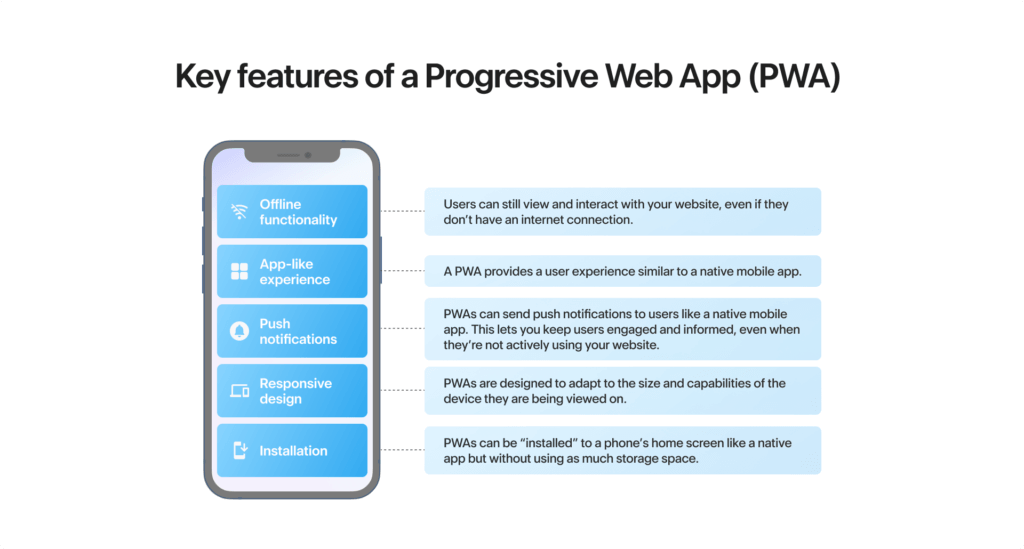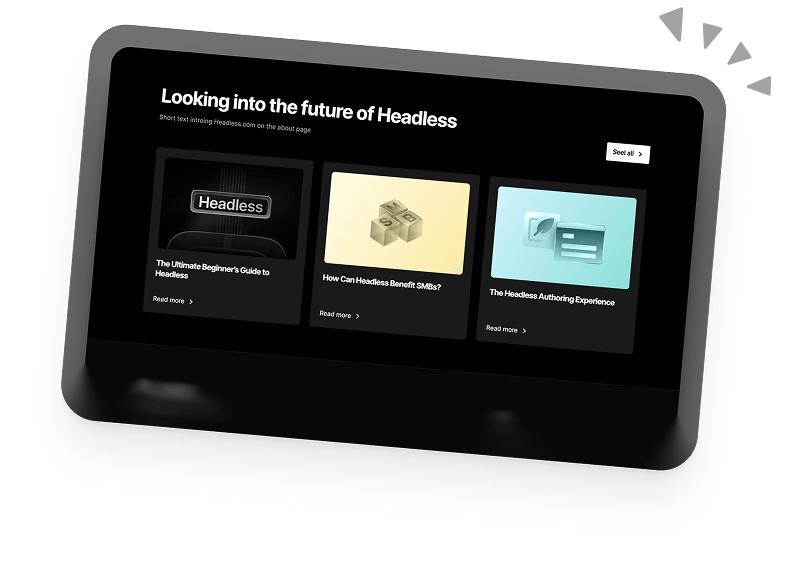How to Convert Your WordPress Site to a Progressive Web App (PWA)
With huge brands like Starbucks, Kubota, and Uber seeing groundbreaking results from implementing Progressive Web Apps (PWAs), it has become clear just how effective the technology is in providing cross-platform access to digital commerce.
The benefits gained from PWAs are so immense that Tinder, for example, saw a cut in load times from 11.91 to 4.69 seconds.
At Drewl, we’ve worked with our fair share of PWAs, and can confirm first hand that they have a tremendous impact on performance and engagement. To see how we managed to reduce load times by 60% using a WordPress PWA, check out our case study on how we revitalised the SoundGuys website!
In this article we’ll provide a complete guide on how to convert your WordPress website into a PWA.
First, we’ll go over what PWAs are and Google’s PWA standards, then delve into the different ways you can create a PWA for your WordPress website regardless of budget or technical know-how.
Let’s get into it.
Understanding PWAs
A progressive web application (PWA) is a web application that employs modern web capabilities to create a user experience comparable to that of a native mobile app.
With a PWA, your WordPress users can access your website when the internet is down, get push alerts, and use it much like an app on their smartphones.
In other words, a PWA enables users to interact with your WordPress website like a mobile app, resulting in a smoother and more convenient experience.
According to a stats report by Lyft, consumers on older smartphones utilise the PWA 11% more often than native users and click “Install PWA” 40% more frequently than “Download App.”
This shows just how convenient having a PWA for your website can be, especially for eCommerce WordPress websites that rely on good user experience.
What does a PWA do?
There are several key features that define a PWA, including:
- Offline functionality
- The ability to send push notifications to the user’s device
- Responsive design
- The ability to be “installed” onto a user’s device

Benefits of a PWA
- Improved performance: PWAs are designed to be fast and efficient, which can improve your website’s overall performance. This can provide a better user experience for your visitors and increase your website’s visibility on search engines.
- Increased engagement: Because PWAs provide an app-like experience, they can increase user engagement with your website. This can lead to increased traffic and a higher conversion rate.
- Improved user experience: By providing offline functionality and a responsive design, PWAs can improve the overall user experience of your website. This can lead to increased customer satisfaction and loyalty.
- Enhanced security: PWAs use HTTPS, which provides an extra layer of security for your website. This can help to protect your website and its users from potential security threats.
- Easier maintenance: PWAs are typically easier to maintain than native mobile apps. This can save you time and resources, allowing you to focus on other aspects of your website.
Google’s PWA standards: the requirements for setting up PWAs
To be considered a true PWA, Google has defined standards that progressive web applications (PWAs) must meet. These standards include:
- HTTPS: PWAs must use HTTPS, providing an extra security layer for your website and its users.
- Service Worker: A service worker is a script that runs in the background, enabling offline functionality and other features of a PWA.
- Web App Manifest: The web app manifest is a JSON file specifying how a PWA should behave when installed on a user’s device. This includes the app’s name, icon, and theme colour.
- Responsive Design: PWAs must be responsive, which means they adapt to the size and capabilities of the device they are being viewed on. This ensures that users have a consistent and optimal experience, regardless of their device.
- Safe Content: PWAs must display safe content free from malware and malicious content.
These standards also apply to WordPress with the addition of two other requirements. These are:
- A WordPress version higher than 3.5
- A PHP version higher than 5.3.0
Note: If you don’t plan on building a PWA from scratch, you don’t have to know much about these standards, as most Do-It-For-You solutions will take care of all that.
How to Convert your WordPress Website into a PWA
There are two main ways to convert a WordPress website into a Progressive Web App (PWA):
- Using a plugin: Several WordPress plugins can help you convert your website into a PWA. These plugins typically provide a simple interface that allows you to enable PWA features on your website without needing to have any technical knowledge.
- Manual implementation: If you have a developer on your team or are comfortable with coding, you can manually convert your WordPress website into a PWA. This involves adding specific code to your websites, such as a manifest file and service worker, to enable offline capabilities, app-like behaviour, and other PWA features.
Converting WordPress to a PWA with plugins
If you’re used to WordPress, you should already have guessed that there’s virtually a plugin for everything. Yes, even converting your WordPress site into a PWA.
Using a plugin is by far the easiest and fastest way of converting any WordPress site into a Progressive Web Application. Aside from the initial setup, there’s basically no maintenance needed, thus, making it the perfect option for non-technical people.
The downside to this method is that it only offers limited customisability. Most PWA conversion plugins only offer basic features with some level of control over the design, i.e., changing colours.
That aside, everything works as it would if you had developed your PWA from scratch.
Below are some of the popular WordPress PWA conversion plugins. Most of these plugins offer a free tier with more powerful features only available in the premium versions.
1. SuperPWA

First on our list is Super Progressive Web Apps (SuperPWA for short) which allows its users to convert WordPress websites into Progressive Web Apps easily.
Once installed, it provides a configuration page that you can use to customise your app’s user interface and experience.
SuperPWA is easy to configure and takes only a few minutes to set up. It also offers a clean uninstall option that removes all associated files and database entries.
Active installationss: 50,000+
2. PWA for WP & AMP
Next up is PWA for WP & AMP, which is just as popular as SuperPWA, with over 200+ 5-star ratings.
This PWA plugin is designed to improve the user experience by bringing the power of Progressive Web Apps to WordPress and AMP.
The plugin offers features like AMP support, multi-site support, UTM tracking, and offline support.
It also allows users to customise icons and background colours, and it has been tested with Google Lighthouse.
Subscribing for the premium version adds the ability to expand your PWA with various features, including a call to action, loading icon library, data analytics, pull to refresh, scroll progress bar, offline forms, navigation bar, quick action, and multilingual compatibility.
Active installations:20,000+
3. PWA
The PWA plugin was developed as a free and basic option for WordPress users, Themes, and Plugins that require PWA functionality.
It’s pretty basic and has the least customisable options out of the box out of all the options listed, but it does get the job done.
Active installations:40,000+
How to Install PWA Plugins in WordPress
To install a PWA plugin on your WordPress site, go to the plugins repository via the dashboard menu and search for “PWA.”
Click the “Install Now” button on any PWA plugin you want and activate.
Depending on the plugin, you should be redirected to a setup wizard that helps you get up and running.
For example, SuperPWA, once activated, enables Progressive web application functionality for your WordPress site and redirects you to a settings page where you make further customisations.
If you’re ever unsure about the setup of a particular PWA plugin, you can check its documentation.
Converting WordPress to a PWA without plugins
Creating a PWA for WordPress from scratch has its benefits. Still, it does require a significant amount of existing coding knowledge and expertise.
In particular, you need to be a proficient JavaScript developer with a confident grasp of popular frontend frameworks like React.
This is why inexperienced site owners may want to use PWA plugins or hire a professional developer, as building a PWA without plugins is a complex task.
If you hire a developer or an agency, the cost of developing a custom PWA is quite expensive, ranging from $1000 to $10,000, depending on the functionality you wish to include.
Site owners should consider going down this route when they have an eCommerce or service-based WordPress site, as these websites benefit the most from a custom PWA.
If you have a simple blog or small company website, spending money on a custom PWA experience is usually not worth it. Even though the manual route gives you more control over the PWA experience, it’s expensive to maintain long-term.
Nevertheless, it is an option if WordPress PWA plugins are not good enough for your needs.
Online PWA Conversion Services
An excellent alternative to using a WordPress plugin is online Website to WordPress conversion services.
With services like PWA Builder (Free) and Mobsted’s PWA App Engine (Paid), you can easily convert your website into a progressive web app (PWA) without the need for any coding knowledge.
These services use various tools and techniques to automatically convert your website into a PWA, allowing you to take advantage of the many benefits of PWAs. In many ways, they offer even more customisability and features than WordPress plugins.
Conclusion
With huge brands seeing groundbreaking results from implementing PWAs, it is clear that this technology is effective and here to stay.
With the ability to work offline, send push notifications, and improve performance, PWAs can increase user engagement and improve the overall user experience of your website.
There are several different ways to convert your WordPress website into a PWA, ranging from using a WordPress plugin to online PWA conversion services.
Regardless of your budget or technical know-how, there is a solution that can help you take advantage of the benefits of PWAs.
Book a 30-min Introduction Call
Let's jump on a quick intro call We'll break down your project, and pinpoint exactly how we can help.



Our clients  Holaa! love working with us see their stories below!
Holaa! love working with us see their stories below!






